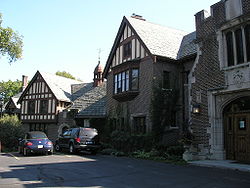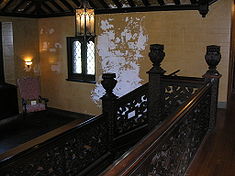- Mayslake Peabody Estate
-
Mayslake Peabody Estate
Nearest city: Oak Brook, Illinois Coordinates: 41°49′42″N 87°57′38″W / 41.82833°N 87.96056°WCoordinates: 41°49′42″N 87°57′38″W / 41.82833°N 87.96056°W Area: 87 acres (0.4 km²) Built: 1919-1921 Architect: Benjamin Marshall
from Marshall and Fox[2]Architectural style: Tudor Revival Governing body: Forest Preserve District of DuPage County NRHP Reference#: 93000836[1] Added to NRHP: November 8, 1994 The rear façade of Mayslake Hall
The Mayslake Peabody Estate is an estate constructed by Francis Stuyvesant Peabody during the American Gilded Age.[3] The estate is located in the western Chicago suburb of Oak Brook, Illinois, United States, and is part of the Mayslake Forest Preserve administered by the Forest Preserve District of DuPage County.
Originally encompassing an area of over 848 acres (3.4 km²),[4] the estate now contains a total area of 87 acres (0.4 km²). The entire complex features the Tudor Revival style 39-room Mayslake Hall, its retreat wing, and the Portiuncula Chapel, a replica of the Chapel of St. Francis in Assisi, Italy.[3] Approximately 22 acres (0.1 km²) of wetlands, lakes, restored prairies and two small oak savannas are included within the 87 acre (0.4 km²) territory.
On November 8, 1994, Mayslake Hall was listed on the National Register of Historic Places.[1]
Contents
History
Construction and early ownership
The Mayslake Peabody Estate was constructed from 1919-1921 by wealthy coal baron and Democratic politician Francis Stuyvesant Peabody. At the time of the estate's construction, Peabody was the owner of one of the largest coal companies in the United States, the Peabody Coal Company, which has since become the largest private sector coal company in the world.[5] For the construction of the estate, Peabody collected 848 acres (3.43 km2) in the eastern portion of DuPage County. Soon after, he started on the construction of Mayslake Hall, his 39-room Tudor Revival style country house. The estate is named in honor of his first wife, who died in 1907, and his daughter, both of whom were named May.[4]
Only a year after Mayslake Hall was completed, on August 27, 1922, Francis Peabody died of a heart attack during a fox hunt on his property. Aged 63 years at the time of his death, Peabody had amassed a personal fortune of $35 million and a business fortune of $75 million.[3]
Later ownership and additions
The Portiuncula Chapel, constructed in 1926, is a replica of the Chapel of St. Francis of Assisi in Assisi, Italy.
After Francis Peabody's death, his family did not wish to reside at the estate, and on March 28, 1924, the estate was sold to the Franciscan Order for a total of $450,000.[4] From 1925, the Franciscans used Mayslake Hall as a retreat house. After Peabody's death, the Portiuncula Chapel, a replica of the Chapel of St. Francis of Assisi in Assisi, Italy, was added to the property in memory of him. The chapel is currently the only known replica of the original chapel in the United States.[3] Originally, the chapel was located on the southern side of the lake, where Peabody died in 1922.[3] It was moved to its present location near the mansion in 1973. Behind the chapel, a semi-circular memorial wall surrounding a flower and herb garden, was constructed by the Franciscan Order of Friars Minor.
In 1927, the St. Joseph Seminary was added to the complex, but was later demolished. In 1951, an additional wing was added to the country house, and construction work began on the St. Paschal's Friary, which was used for housing retired and aging friars. During the 1930s and 1970s, the Franciscans sold large portions of the estate, leaving only 87 acres (350,000 m2) from the original 848-acre (3.4 km2) territory.
In 1991, the Franciscans announced the pending sale of the remaining 87 acres (350,000 m2) to a developer who planned to raze remaining buildings and build 130 luxury homes. Conservationists, historic preservationists and DuPage County citizens formed a group to save the historic property.[4] With the assistance of the group's efforts, DuPage County voters approved a $17.5 million referendum providing the Forest Preserve District with funds to purchase Mayslake in 1992.[4] The area is now part of the Forest Preserve District of DuPage County. The estate is also home to First Folio Shakespeare Festival. The Mayslake Peabody Estate was used as the main location for the independent feature film, "Eye of the Sandman,"[6] produced by a Chicago-based non-profit organization, Split Pillow in November 2007.
Architecture
A hand-carved staircase of imported walnut leads guests onto the second floor. Architectural damage can be seen on the walls.
Mayslake Hall was designed in the Tudor Revival style by Benjamin Marshall from Marshall and Fox, an architectural firm based in Chicago. The country house somewhat resembles Compton Wynyates, a 15th-century manor house in Warwickshire, England.[4] The building's architectural elements include irregular massing, decorative half-timbering and groups of tall, narrow windows.
Mayslake Hall features 39 rooms, including a library, kitchen, private study, numerous bedrooms and bathrooms, servant's quarters, and other rooms. Francis Peabody's private study contains a secret staircase leading to a bomb proof basement.[4]
During years of disrepair, the building suffered significant architectural and structural damage, but is being remediated by a restoration process within Mayslake Hall. The Forest Preserve District of DuPage County has allowed students from the Art Institute of Chicago to participate in three week restorations with the Historic Preservation Program, as well as other participants in the estate's restoration. A wide range of informational and educational programs are available at the Mayslake Peabody Estate.
References
- ^ a b "ILLINOIS - Du Page County". National Register of Historic Places. http://www.nationalregisterofhistoricplaces.com/IL/Du+Page/state.html. Retrieved 2007-09-16.
- ^ "Peabody Estate at Mayslake". Partners in Preservation. http://www.partnersinpreservation.org/index.php?sec=exploc&locID=13. Retrieved 2007-09-16.
- ^ a b c d e "Mayslake Forest Preserve". Forest Preserve District of DuPage County. Archived from the original on 2007-08-30. http://web.archive.org/web/20070830193542/http://www.dupageforest.com/preserves/mayslake.html. Retrieved 2007-09-16.
- ^ a b c d e f g Cunniff, Bill (May 24 2002). "Coal baron's 1920 mansion in Oak Brook opens to public". Chicago Sun-Times (Find Articles). http://findarticles.com/p/articles/mi_qn4155/is_20020524/ai_n12465523. Retrieved 2007-09-16.[dead link]
- ^ "Peabody Energy (NYSE:BTU)". Peabody Energy. http://www.peabodyenergy.com/default-netscape.asp. Retrieved 2007-09-17.
- ^ "Eye of the Sandman". Spit Pillow. http://www.splitpillow.com/eyeofthesandman. Retrieved 2008-04-24.
External links
- "Mayslake Peabody Estate". Mayslake Peabody Estate website. http://www.mayslakepeabody.com/. Retrieved 2007-09-16.
U.S. National Register of Historic Places Topics Lists by states Alabama • Alaska • Arizona • Arkansas • California • Colorado • Connecticut • Delaware • Florida • Georgia • Hawaii • Idaho • Illinois • Indiana • Iowa • Kansas • Kentucky • Louisiana • Maine • Maryland • Massachusetts • Michigan • Minnesota • Mississippi • Missouri • Montana • Nebraska • Nevada • New Hampshire • New Jersey • New Mexico • New York • North Carolina • North Dakota • Ohio • Oklahoma • Oregon • Pennsylvania • Rhode Island • South Carolina • South Dakota • Tennessee • Texas • Utah • Vermont • Virginia • Washington • West Virginia • Wisconsin • WyomingLists by territories Lists by associated states Other Categories:- Oak Brook, Illinois
- National Register of Historic Places in DuPage County, Illinois
- Tudor Revival architecture in the United States
- Houses completed in 1921
- Houses on the National Register of Historic Places in Illinois
- Houses in DuPage County, Illinois
- Visitor attractions in DuPage County, Illinois
Wikimedia Foundation. 2010.




